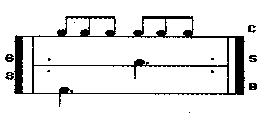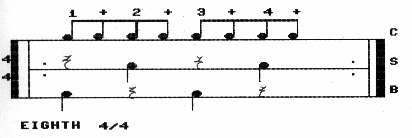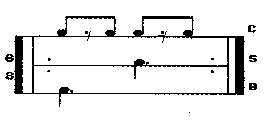
 School of Drums
School of Drums
The following few pages will provide you with the basic beat patterns needed to play almost any song, regardless of your personal taste in music. As you study and learn these beats, notice that a mathematical pattern becomes evident between the speed (or tempo) of the beat and the number of cymbal (hi-hat) notes being played. Slow songs require more fill notes on the cymbal and fast songs require less. (Hairstyles and body-art have nothing what-so-ever to do with any of this.) This first video (below) is a .wmv file. It will work best with Windows Media Player. In most cases, the Internet Explorer browser will choose that application
automatically if it is installed on your system. I think Microsoft makes a version
of 'IE' and 'Windows Media Player' for nearly all devices. So, for best results with the videos, use Internet Explorer and Windows Media Player, when playing the .wmv video below: The (four) vid formats below may not loop in a 100% accurate way but at least one of them should play on almost any hand-held device or computer. Video:
HINT: On top of the 16th rock example (above) you will see the 'apprroved' counting procedure. I rarely use it myself. It tends to confuse as much as it helps. It often helps (some people) to say the actual words "one,ee,and,aah,two,ee,and,aah" and so on. You will be saying "and" with each "+" (plus-sign) that you see. Pat your foot as you say "one" and tap your left hand as you say "two". Follow through and keep it going. Try it! If the counting tip helps, then use it. Otherwise just imitate the SOUND of the rhythm, either from the audio file or the video file. Be aware: These videos are designed to loop or repeat in steady time. Some of the video
players tend to hang at the end of the pattern, which causes a terrible lag in some of the clips. In other words, the audio files give a better impression of how the beats should sound, than the videos. Remember that as you click through the various video clips. A lot of them might
hang and drag in a terrible way that may give the student the wrong idea as to how the beats should actually sound. We need to blame the player applications for that little flaw. There's little we can do to fix it. 4 different Video formats: These beat patterns should be steady. Some devices
may lag as they loop. It may impossible to fix that until all the video players
work exactly the same.
Video: These beat patterns should be steady. Some devices
may lag as they loop. Video: These beat patterns should be steady. Some devices
may lag as they loop.
IT IS MUCH EASIER THAN THAT! Find a familiar song in
the shuffle category and let it play as you study this beat. Listen deeply to the song
and feelthe rhythm. Move ahead if you are having problems. It will seem much
easier after you have been playing a while longer.
NOTE: These patterns may be written many various ways. Only the most simple forms
are being shown here.
Four additional video formats: These beat patterns should be steady. Some devices
may lag as they loop.
Musical Time - Finite to Infinity: Finite to Infinity: Discover the (lost) 500 year-old enigmatic secrets hidden within
the current time-signature system. Seven short mesmerizing and easy-to-follow lessons will lead you quickly and easily towards
(musical-time) guru status. You will learn to visualize (read, write or feel) the existence This should lead
directly to the e-book. This very informative little booklet will amaze you
with hundreds of valuable tips and insider secrets! HOW TO: Purchase old/used drumsets for pennies and resell them for decent
profits.
![]()
![]() The Basic Dance Beats
The Basic Dance Beats
![]() NOW WTH VIDEO!
NOW WTH VIDEO!![]()
![]()
Back. . . to the 'Drum Lesson Menu'. . .
The bulk of modern music is based on a few simple beat patterns. Learn those beats and play any song. Playing with music will come natural and you will be playing by 'ear' once you have mastered these rhythms. It is that easy to become a drummer!
IMPORTANT TIP!
Make a bookmark and get a printout of this page. Practice these drumbeats as you go through your day. Learn each beat separately. Imagine a drum set in front of you, wherever you are. Repeat the moves of each beat, steadily, over and over, until they become ingrained into your memory, (MEMORIZED). Shortly after that, no matter what songs play on the radio, you will discover that you can easily, listen, analyze, then jump-in and play along . . . almost like magic. When that begins to occur (and it will), come back to this web site and proceed with the other lessons. It is crucially important
that you should MEMORIZE, these beat patterns pretty well, before moving on to another lesson. This is the stuff that will give you the ability to become a 'natural' drummer.
Dance beat #1: 16th 'SLOW ROCK' 4/4
Approximately 15 songs per 100 will utilize some form of this basic beat.

![]() Hear the Basic 16th ROCK Beat. Midi (audio) file only
Hear the Basic 16th ROCK Beat. Midi (audio) file only
![]() VIDEO: Click here to 'Play', see, and hear the (.wmv) 16th-note Rock Beat, video.
VIDEO: Click here to 'Play', see, and hear the (.wmv) 16th-note Rock Beat, video. I am assuming that you can read and understand these patterns. If you are experiencing difficulty, then return to the previous lesson and learn to READ DRUM NOTATION. Go over that lesson until you understand it, then come back.
Dance beat #2: 6/8 'BLUES'
Approximately 12 songs per 100 will utilize some form of this basic beat.

![]() Hear the Basic BLUES Beat
Hear the Basic BLUES Beat
![]() VIDEO: Click here to 'Play', see, and hear the (.wmv) Blues Beat, video. It works best in IE with Windows Media Player.
VIDEO: Click here to 'Play', see, and hear the (.wmv) Blues Beat, video. It works best in IE with Windows Media Player. Writing conventions dictate that most of these patterns may be written several ways.
For example, the above pattern could be written as '8th Triplet 2/4'; '8th Triplet 4/4'; 6/8 or even 12/8.
Don't let that issue confuse you. The Blues Beat will sound the same, no matter how it is written. This confusing issue will be explained in depth
as you study 'Finite to Infinity'.
Dance beat #3: Eighth 'ROCK' 4/4
Approximately 45 songs per 100 will utilize some form of this basic beat.

![]() Hear the Basic ROCK Beat
Hear the Basic ROCK Beat ![]() VIDEO: Click here to 'Play', see, and hear the (.wmv) 8th Rock Beat, video. It works best in IE with Windows Media Player.
VIDEO: Click here to 'Play', see, and hear the (.wmv) 8th Rock Beat, video. It works best in IE with Windows Media Player.
We studied this beat in the previous lessons because it is the most often used. It is
included again here so that you can see how it falls into the tempo scale of primary
dance beats. This is a medium tempo beat. Remember, faster tempos (speeds)
require less notes on the cymbal.
Dance beat #4: 6/8 'SWING/SHUFFLE'
Approximately 20 songs per 100 will utilize some form of this basic beat.

![]() Hear the Basic SHUFFLE Beat
Hear the Basic SHUFFLE Beat
![]() VIDEO: Click here to 'Play', see, and hear the (.wmv) Shuffle Beat, video. It works best in IE with Windows Media Player.
VIDEO: Click here to 'Play', see, and hear the (.wmv) Shuffle Beat, video. It works best in IE with Windows Media Player. Swing/shuffle is the nightmare of them all and will be much easier to learn
if associated with a song. Notice the eighth
rests on the cymbal line. Think in groups of three but omit the middle cymbal
of each group. . . (what a nightmare).
Dance beat #5: Quarter note 4/4 or 'QUARTER ROCK'
Approximately 2 songs per 100 will utilize some form of this basic beat.
![]() VIDEO: Click here to 'Play', see, and hear the (.wmv) Quarter Rock Beat, video. It works best in IE with Windows Media Player.
VIDEO: Click here to 'Play', see, and hear the (.wmv) Quarter Rock Beat, video. It works best in IE with Windows Media Player. This is a dance beat with many nicknames. It may be called Quarter rock, Doubletime, Cut time, Jazz, Breakdown, Uptempo, Quicktime, Punk, Polka or others that I haven't mentioned. If a song is fast . . . really fast, then this is the beat to use.
Back to Drum Lesson Menu #1:

![]() Copyright
Bill Powelson 1965-1994-2008-2014 @ all rights reserved.
Copyright
Bill Powelson 1965-1994-2008-2014 @ all rights reserved.![]()
![]()
Cool Drum Solos.
Video Drum Solo Lessons Free

Drum Solo Video: Click to 'LEARN' Watch and Learn Now! PLAY Great Drum Solos within hours (not years).
NEW 'Subliminal Method' teaches drum solo techniques PAINLESSLY!
Master rudiments 'NATURALLY' without boring regimentation or serious discipline.
Listen, watch and PLAY your way to awesome drum solos (and polished rudiments) BY SIMPLY HAVING FUN. . . . It works, folks!
Don't be a skeptic until you at least try it first. You owe it to yourself toTRY IT RIGHT NOW!
![]()
![]()
Membership Includes
EVERYTHING FREE! All the E-book icons are "hot" here at the password site. Click an e-book icon and go directly to the product.
Bill Powelson's Other Drumming Courses
![]()
